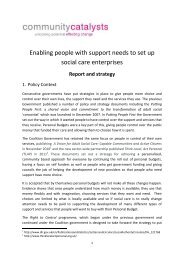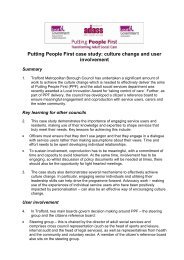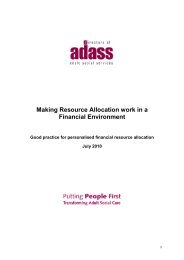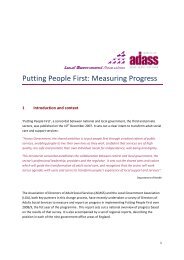'Only a footstep away' - Skills for Care - Think Local Act Personal
'Only a footstep away' - Skills for Care - Think Local Act Personal
'Only a footstep away' - Skills for Care - Think Local Act Personal
- No tags were found...
You also want an ePaper? Increase the reach of your titles
YUMPU automatically turns print PDFs into web optimized ePapers that Google loves.
neighbourhood.” (Blackman 2006, 25) Theofficial definition of a ‘poor neighbourhood’is that used in the English House ConditionSurvey which is based on a neighbourhoodhaving over 10% of its dwellings assessedas seriously defective. Using this measure,around 10% of the national housing stockwas classed in ‘poor neighbourhoods’ in2001.3.5 There is also some evidence tosuggest that the physical layout of both thehouse and the neighbourhood can shapelevels of neighbourly activity. Brown andBurton (1998), <strong>for</strong> example, demonstrated(in the USA) the significance of the frontporch as a semi-public space in whichnon-threatening and non-intrusiveneighbourly relations could be initiated andreproduced. And the Abrams studies(Bulmer 1986) found that the segregationof elderly people in bungalows and flats cutthem off from neighbours other thanpeople of their own age, and that thisaccentuated social isolation.length of residence3.6 The Abrams studies concluded thatthe most obvious factor accounting <strong>for</strong>variations in neighbouring was the longevityof the settlement and the length ofresidence there of particular households.Clear differences were observed betweenlong-time residents and newcomers interms of contact with neighbours and thesort of help exchanged. This is partlyexplicable in terms of exchange theory. Inthe modern neighbourhood milieu,exchange relations will typically evolve as aslow process, starting with minortransactions in which little trust is requiredbecause little risk is involved. Only whenmutual trust is more firmly established willthere be a gradual expansion of mutualsupport.3.7 This picture is supported by moreextensive longitudinal studies. Wenger andher colleagues analysed data on lonelinessamong older people from the BangorLongitudinal Study of Ageing. (Wenger1996). They reported that the mostsuccessful network in terms of avoidingloneliness and isolation was the ‘locallyintegrated support network’, which wasusually based upon long-term residence. Inanother paper based upon the same datathe authors further noted that people insuch networks were less likely to needstatutory services to help with personalcare. (Wenger 2001)social polarisation‘Only a <strong>footstep</strong> away’? 73.8 Reciprocal care between neighboursgrows where in<strong>for</strong>mation and trust arehigh, and where resources <strong>for</strong> satisfyingneeds in other ways are low. This is mostlikely to occur in relatively isolated,relatively closed and relatively threatenedsocial milieu with highly homogeneouspopulations. This could be part of a viciouscircle of decline as qualitatively better jobsand homes elsewhere will be in reach of atleast some of the residents, and theirdeparture further deepens themarginalisation of those remaining. Dorlingand Rees (2003) note that with continuingsocio-spatial polarisation, areas are nowmore easily typified as being old andyoung, settled and migrant, black andwhite or rich and poor. Indeed, in theirstudy of young people growing up indepressed parts of Teesside, Macdonaldand Marsh (2005) found that most choseto remain living in very deprivedneighbourhoods, seeing these as ‘normal’.<strong>Local</strong> social divisions were perceivedinstead at a very fine-grained scale such asstreets or parts of an estate withtroublesome residents.personal circumstances3.9 Abrams found that apart fromproximity, the most salient influencesmentioned as promoting neighbourliness
















